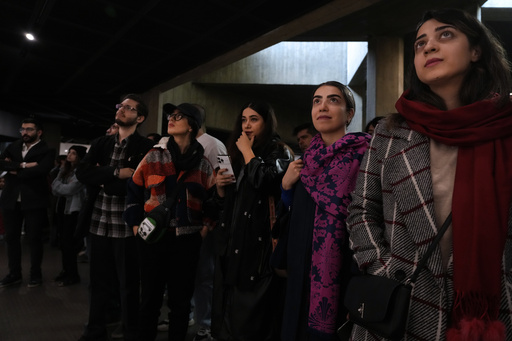
TEHRAN, Iran — Amid rising tensions with Western nations and ongoing unrest within its borders, Tehran is unveiling a fresh exhibit at the Tehran Museum of Contemporary Art, showcasing Western art pieces that have been hidden from the public eye for over a decade.
The exhibition titled “Eye to Eye” has attracted numerous attendees, especially women who have chosen to reveal their hair as they explore the museum’s underground galleries located in Laleh Park. Although the authorities have taken no formal notice of their presence, the gathering signifies a notable shift in life within the country over recent years. This change occurs against the backdrop of Iran’s theocratic regime, which continues to enrich uranium to near-weapons grade levels and engage in military actions against Israel amidst ongoing conflicts in the Middle East.
Aida Zarrin, a young visitor at the museum, expressed her astonishment at witnessing these artworks. “The first feeling that impacted me was disbelief. I told my parents that it’s hard to believe I’m actually looking at these pieces, which have been kept from us for so long,” she commented. “If we can attend events like this and enjoy artworks just like the rest of the world, that’s enough for us. They hold significant value.”
The Tehran Museum of Contemporary Art was established by Mohammad Reza Pahlavi, Iran’s former king, and his wife, Empress Farah Pahlavi, during the late 1970s when the oil industry thrived, propelling Western economies into stagnation. The museum opened its doors to an impressive collection of famous works from Pablo Picasso, Mark Rothko, Claude Monet, Jackson Pollock, and others, positioning Iran as a significant player on the global cultural scene.
However, following the Islamic Revolution in 1979, the newly installed Shiite clerics closed the museum and stored the artworks in its vaults to preclude any potential offense to Islamic values or perceptions of Western cultural influence. Many pieces, including cubist, surrealist, impressionist, and pop art, have remained untouched for decades. While most of the collection is believed to still exist, notable damage was done to an Andy Warhol print of the empress during the revolution.
Today, the museum’s collection is estimated to be worth billions of dollars. Despite the economic challenges faced by Iran due to Western sanctions, museum officials have managed to maintain the collection, although past trade-offs for Iranian historical artifacts have occurred. The situation may become more challenging with the incoming administration of President-elect Donald Trump.
The collection has periodically resurfaced in tandem with the fluctuating climate of Iranian politics. The current exhibition features over 120 works from iconic artists such as Picasso, Andy Warhol, and Francis Bacon, alongside pieces from renowned Iranian artists. One of Warhol’s pieces, “Jacqueline Kennedy II,” depicts the former First Lady mourning her husband’s assassination. Additionally, another Warhol portrait of Mick Jagger has caught the attention of visitors snapping photos with their phones.
“The significance of these works in art history is what sets this exhibition apart from others,” remarked Jamal Arabzadeh, the curator of the event. “Many attendees who have had limited exposure to art are discovering the museum for the first time. This is an opportunity for the community to engage with art, and we have reason to be proud.”
The display of Western art comes as the Iranian government has historically resisted various Western cultural elements, including Barbie dolls and characters from the animated series “The Simpsons.” Such items have been classified as un-Islamic, perceived as part of a broader cultural contention against the Islamic Republic.
With admission priced at the equivalent of merely 14 U.S. cents, this exhibition represents a rare opportunity for a government-sanctioned event that is free from political or religious undercurrents. Notably, many women defied the country’s mandatory hijab law during their visit. Although there have been fewer crackdowns following the election of reformist President Masoud Pezeshkian in July, isolated arrest cases continue to invoke frustration among the populace.
For many Iranians, financial constraints stemming from the country’s weakening currency have made international travel and access to foreign museums incredibly difficult. “This event is immensely appealing to art lovers,” noted a woman who identified only as Dolatshahi. “Not everyone has the chance to visit museums abroad, making it incredibly exhilarating to view these pieces here. I had no idea I could see works by van Gogh and Picasso in my own country.”
